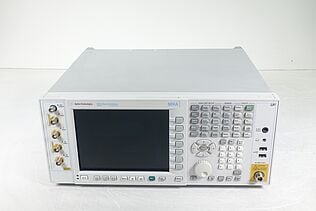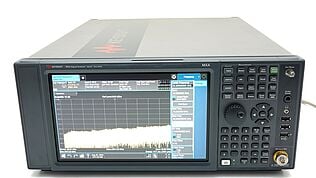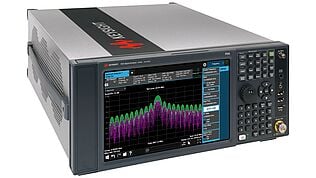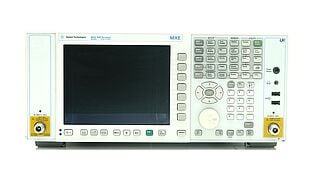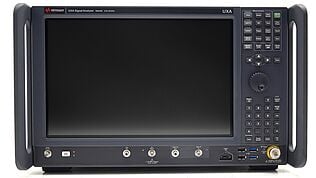- Introduction
- How to Use the Bandwidth Calculator
- Streamline Your Testing with Quality Used Equipment – Explore Our Offers Today
- What is Bandwidth?
- How to Calculate Bandwidth
- Factors That Can Affect Your Bandwidth Calculations
- Common Mistakes and How to Avoid Them
- Practical Applications of Bandwidth Calculations
- Bandwidth Measurement Technology
- Ensure Precision in Every Calculation with the Right Bandwidth Tools
- Whenever You’re Ready, Here Are 5 Ways We Can Help You
Digital Signal Bandwidth
Data Transfer Rate
Imagine being able to quickly determine bandwidth and adjust it to meet your exact needs. Think about having a tool that helps calculate network bandwidth performance under different conditions, even before you build it.
Instead of dealing with the usual frustrations—unexpected circuit behavior, wasted resources on network design flaws, and endless rounds of testing—you could streamline the process.
Our bandwidth calculator is designed to help you predict bandwidth performance quickly and accurately, letting you make data-driven adjustments without diving into complex math every time. In the following sections, we'll guide you through using this calculator and explain how it can save you time and frustration in your daily tasks.
How to Use the Bandwidth Calculator
A bandwidth calculator is a tool that helps engineers compute the required bandwidth for digital signals or the time needed to transfer data across a network. By using input parameters like resolution, color depth, and refresh rate, or file size and transfer rate, the calculator offers quick insights into how a circuit or data transfer might perform under different conditions.
Here’s a step-by-step guide to using our bandwidth calculator:
- Select the Scenario: Choose between "Digital Signal Bandwidth" or "Data Transfer Rate" based on your requirements.
- Enter the Required Inputs:
- For Digital Signal Bandwidth: Select the resolution, enter the color depth (in bits), and set the refresh rate (in Hz).
- For Data Transfer Rate: Enter the file size (in MB) and the transfer rate (in Mbps).
- Click Calculate: Hit the "Calculate" button for the desired scenario.
- Review the Results: The calculator will display the total bandwidth in Gbps for digital signals or the estimated time to transfer data in seconds.
By following these steps, you can quickly obtain the necessary information to design or troubleshoot your circuit.
Interpreting the Results
The calculated results provide valuable insights:
- Digital signal bandwidth: The result, expressed in Gbps, indicates the amount of data transferred per second. Higher bandwidth values mean more data capacity but may require better hardware or infrastructure to handle it efficiently.
- Data transfer time: This value shows how long it will take to transfer a file of a specific size at a given rate. Shorter times suggest faster performance, which is crucial for optimizing network efficiency.
Tips for Validating the Calculator’s Accuracy
- Cross-reference results: Manually calculate bandwidth using known formulas and compare the results.
- Use simulation tools: Leverage simulation software to test circuit performance under different scenarios.
- Check input values: Ensure the input parameters (resolution, color depth, refresh rate, etc.) are correct and relevant to your specific use case.
- Adjust for real-world factors: Consider factors like signal interference, hardware limitations, and environmental conditions that may affect actual performance.
Streamline Your Testing with Quality Used Equipment – Explore Our Offers Today
What is Bandwidth?
In electrical engineering, bandwidth refers to the range of frequencies a circuit can effectively transmit or process. It is the difference between the highest and lowest frequencies in a continuous set that a circuit or device can handle without significant signal loss or distortion. Measured in Hertz (Hz), bandwidth represents a circuit's capacity to carry data or signals.

A broader bandwidth allows more data to be transmitted at higher speeds, improving performance. The bandwidth directly correlates with the frequency response of a circuit, defining how well it can handle different frequencies, impacting overall signal quality and fidelity.
How to Calculate Bandwidth
Calculating bandwidth can involve several methods, from manual calculations to using a dedicated bandwidth calculator. Manual calculations often rely on mathematical formulas specific to the type of circuit, such as RC circuits, LC circuits, or filters. For example, the bandwidth of an RC circuit is determined by the formula:
Bandwidth (BW) = 1 / (2 * π * R * C)
For an LC circuit, the formula is:
Bandwidth (BW) = R / L
Engineers often use these formulas to manually calculate bandwidth, considering factors like resistance (R), capacitance (C), and inductance (L). Automated tools, like bandwidth calculators, simplify these calculations by allowing you to input circuit parameters directly, reducing the risk of errors and saving time.
Example Calculations:
- RC Circuit: For a circuit with R = 1000 ohms and C = 1 microfarad, the bandwidth is approximately 159 Hz.
- LC Circuit: For an inductor (L) of 2 mH and resistance (R) of 4 ohms, the bandwidth is 2000 Hz.
| Method | Manual Calculation | Automated Calculation |
| Pros | Deep understanding, no tool dependency | Fast, accurate, and easy to use |
| Cons | Time-consuming, prone to errors | Limited by tool accuracy and dependency on input correctness |
By comparing these methods, you can choose the one that best suits your needs and expertise level.
Factors That Can Affect Your Bandwidth Calculations
Several factors can influence the accuracy of bandwidth calculations, and understanding these is essential for reliable circuit design and analysis:
- Signal characteristics: The frequency and amplitude of the input signal play a crucial role. Higher frequencies may require more bandwidth, while signal amplitude variations can impact the range of frequencies a circuit can handle.
- Impedance: The impedance of the circuit components, including resistors, capacitors, and inductors, affects how signals propagate through the circuit. Mismatched impedance can cause reflections or losses, distorting bandwidth measurements.
- Component tolerances: Variations in component values, such as resistors and capacitors, can lead to discrepancies between theoretical and actual bandwidth. Even small deviations from the specified values can affect the circuit's performance.
- External factors: Environmental factors like temperature changes and noise from surrounding electronics can introduce errors in bandwidth calculations. Temperature fluctuations can alter component behavior, while external noise can interfere with signal transmission.
- Calibration of instruments: The accuracy of instruments used to measure and calculate bandwidth, like oscilloscopes and network analyzers, heavily depends on their calibration. Improperly calibrated equipment can produce inaccurate results, leading to flawed calculations. To maintain precision, it's vital to perform regular calibration checks and adhere to manufacturer recommendations.
By accounting for these factors, you can ensure more accurate bandwidth calculations and enhance the performance of your circuits.
Common Mistakes and How to Avoid Them
These are the most common mistakes when calculating bandwidth:
- Incorrect input values: Entering wrong values for parameters like resistance, capacitance, or signal frequency can lead to significant errors. Always double-check your inputs to ensure they match the actual circuit specifications.
- Misinterpreting results: Automated tools provide quick calculations but may not account for all variables, such as component tolerances or external factors. Misinterpreting these results can lead to incorrect conclusions about circuit performance.
- Over-reliance on calculators: While bandwidth calculators simplify the process, relying solely on them without understanding the underlying principles can be risky. Calculators may not handle complex or unique circuit configurations correctly, leading to inaccurate results.
Best Practices for Ensuring Accuracy
- Double-check calculations: Always verify automated results with manual calculations to confirm their accuracy. This practice helps you spot any discrepancies early on.
- Use simulation software: Running circuit simulations can provide a clearer picture of performance under different conditions and help validate your calculations.
- Understand the fundamentals: Develop a strong grasp of the principles behind bandwidth calculation to reduce dependence on calculators and make more informed decisions.
By following these best practices, you can avoid common mistakes and ensure your bandwidth calculations are precise and reliable.
Practical Applications of Bandwidth Calculations
Seeing how bandwidth calculations play a role in so many practical applications highlights why getting them right matters. Now, let’s look at the different ways you can calculate bandwidth and the tools that can help.
- Circuit Design
- Filters: Engineers calculate bandwidth to design low-pass, high-pass, and band-pass filters, ensuring they only allow desired frequencies while blocking unwanted ones.
- Amplifiers: Bandwidth determines the range of frequencies an amplifier can handle without distortion. Accurate calculations help optimize amplifier performance for audio, RF, or other applications.
- Communication Systems
- Data transmission: In digital communication, bandwidth calculations are essential for determining the maximum data rate that a channel can support. For example, in fiber optic or wireless networks, engineers use these calculations to ensure efficient and reliable data transfer.
- Signal integrity: Engineers use bandwidth to assess how different transmission mediums will affect signal quality, helping prevent data loss or degradation.
- RF Circuit Design:
- Antenna design: Calculating bandwidth helps in designing antennas that can efficiently transmit and receive signals within specific frequency ranges, vital for applications in telecommunications, radar, and broadcasting.
- Oscillators and mixers: Engineers use bandwidth calculations to fine-tune oscillators and mixers to operate correctly in the desired frequency range, ensuring signal stability and minimizing interference.
By using bandwidth calculations in these practical scenarios, engineers can optimize circuit performance, ensure signal integrity, and enhance communication system efficiency.
Bandwidth Measurement Technology
Several tools and technologies are available for measuring and validating bandwidth in circuits and communication systems:
- Spectrum Analyzers:
- Advantages: Ideal for measuring signal frequency, power, and spectrum. Excellent for identifying interference and noise in a wide range of frequencies.
- Limitations: Less effective for time-domain measurements; limited bandwidth range.
- Real-world use: Spectrum analyzers are used in wireless communication to identify and resolve signal interference issues.
- Network Analyzers:
- Advantages: Network analyzers measure network parameters like impedance, return loss, and S-parameters, providing a comprehensive view of circuit behavior.
- Limitations: Requires a controlled environment and can be complex to set up and interpret.
- Real-world use: Commonly used in RF design to validate the bandwidth of antennas, filters, and other components.
- Oscilloscopes:
- Advantages: Oscilloscopes are excellent for time-domain analysis and observing signal waveforms. Useful for real-time troubleshooting.
- Limitations: Limited frequency range compared to spectrum analyzers; less effective for frequency-domain analysis.
- Real-world use: Oscilloscopes are used in circuit debugging to measure the bandwidth of signals and verify circuit performance in real-time.
| Tool | Best For | Limitations |
| Spectrum Analyzers | Frequency measurement and noise analysis | Limited to frequency-domain analysis |
| Network Analyzers | Comprehensive network parameter analysis | Complex setup and interpretation |
| Oscilloscopes | Real-time signal observation and time-domain analysis | Limited frequency range |
Buying used and refurbished equipment from Keysight offers significant benefits, including cost savings, fast delivery, and the assurance of Keysight’s quality standards, providing reliable tools for accurate bandwidth measurements.

Subscribe to Get Our Latest News, Updates, and Articles.
Ensure Precision in Every Calculation with the Right Bandwidth Tools
Engineers often struggle with the complexities of accurate bandwidth calculations, from incorrect inputs to unreliable results from poorly calibrated tools.
In this guide, we’ve explored how to effectively calculate and measure bandwidth, highlighted common mistakes to avoid, and discussed the practical applications of accurate bandwidth measurements in engineering.
With the right tools, you can quickly adjust circuits to meet specific requirements and predict performance before even building them, turning those "what-ifs" into "what’s next."
At Keysight, we make reliable test results accessible and affordable by offering certified, pre-owned equipment that delivers top-tier performance at a fraction of the cost. With our tools, you can ensure every calculation is precise, every circuit is optimized, and every decision is backed by accurate data—helping you achieve your goals with confidence.
Whenever You’re Ready, Here Are 5 Ways We Can Help You
- Browse our Premium Used Network Analyzers, Oscilloscopes, Signal Analyzers and Waveform Generators
- Call tech support US: 1 800 829-4444 Press #, then 2. Hours: 7 am – 5 pm MT, Mon– Fri
- Talk to our sales support team by clicking the icon (bottom right corner) on every offer page.
- Create an account to get price alerts and access to exclusive waitlists
- Talk to your account manager about your specific needs.





















